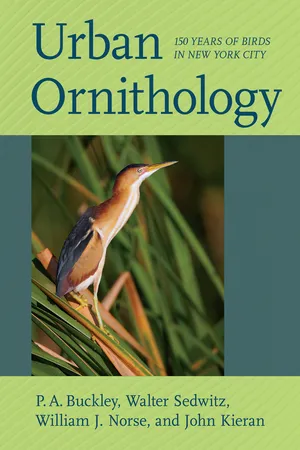
Urban Ornithology
150 Years of Birds in New York City
- 472 pages
- English
- ePUB (mobile friendly)
- Available on iOS & Android
Urban Ornithology
150 Years of Birds in New York City
About this book
Urban Ornithology is the first quantitative historical analysis of any New York City natural area's birdlife and spans the century and a half from 1872 to 2016. Only Manhattan's Central and Brooklyn's Prospect Parks have preliminary species lists, not revised since 1967, and the last book examining the birdlife of the entire New York City area is now more than fifty years old.
This book updates the avifaunas of those two parks, the Bronx, and other New York City boroughs. It treats the 301 bird species known to have occurred within its study area—Van Cortlandt Park and the adjacent Northwest Bronx—plus 70 potential additions. Its 123 breeding species are tracked from 1872 and supplemented by quantitative breeding bird censuses from 1937 to 2015. Gains and losses of breeding species are discussed in light of an expanding New York City inexorably extinguishing unique habitats.
Frequently asked questions
- Essential is ideal for learners and professionals who enjoy exploring a wide range of subjects. Access the Essential Library with 800,000+ trusted titles and best-sellers across business, personal growth, and the humanities. Includes unlimited reading time and Standard Read Aloud voice.
- Complete: Perfect for advanced learners and researchers needing full, unrestricted access. Unlock 1.4M+ books across hundreds of subjects, including academic and specialized titles. The Complete Plan also includes advanced features like Premium Read Aloud and Research Assistant.
Please note we cannot support devices running on iOS 13 and Android 7 or earlier. Learn more about using the app.
Information
SPECIES ACCOUNTS
Ducks, Geese, Swans: Anatidae
Fulvous Whistling-Duck Dendrocygna bicolor
NYC area, current
NYC area, historical
Study area, historical and current
Pink-footed Goose Anser brachyrhynchus
NYC and study areas, current
Greater White-fronted Goose Anser albifrons
NYC area, current
NYC area, historical
Study area, historical and current
Comments
Snow Goose Chen caerulescens
NYC area, current
Bronx region, historical
NYC area, historical
Study area, historical and current
Brant Branta bernicla
NYC area, current
Table of contents
- List of Figures
- List of Tables
- Preface
- Acknowledgments
- Introduction
- Avifaunal Overview
- Introduction to the Species Accounts
- Species Accounts
- Appendixes
- Literature Cited
- About the Authors
- Indexes